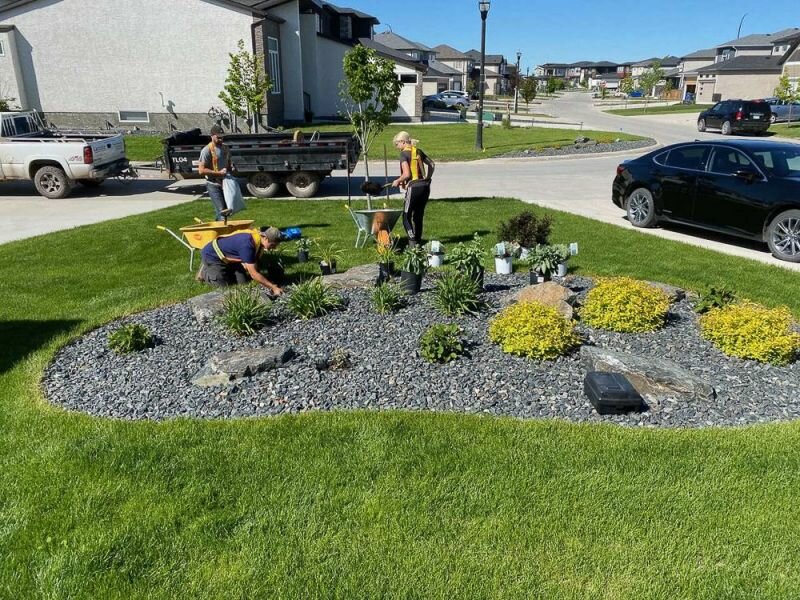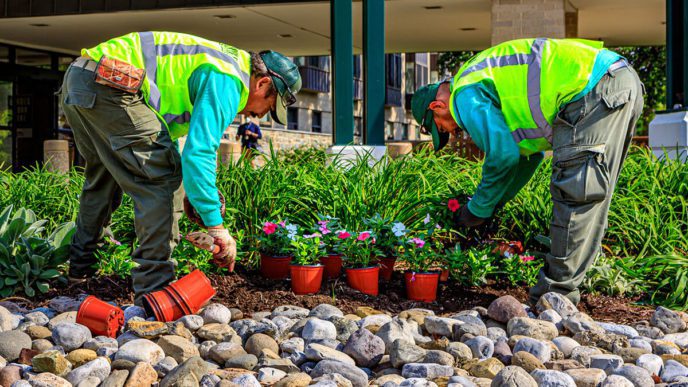Recognizing the Comprehensive Extent of Works in Expert Landscaping Services
The substantial range of specialist landscape design services incorporates a variety of basic elements - landscaping services. It consists of landscape style concepts, plant option, and hardscaping features. In addition, it addresses watering systems and maintenance strategies. Each aspect plays a crucial role in creating functional and cosmetically pleasing exterior rooms. Understanding exactly how these parts interact can reveal much regarding the art and scientific research of landscape design. The trip right into this detailed field is just beginning.
Landscape Style Principles
Reliable landscape layout principles are crucial for producing harmonious outside areas that improve both aesthetic charm and functionality (Learn More). These concepts lead the arrangement of aspects within the landscape, making certain a natural aesthetic experience. Secret elements include equilibrium, which disperses aesthetic weight equally; percentage, which connects the dimension of different aspects to every other and the space; and unity, which creates a sense of wholeness via constant themes and products

Plant Choice and Installment
In the domain of professional landscaping, plant selection and setup play a vital duty in attaining a thriving garden. Emphasizing native plant advantages, seasonal considerations, and the particular soil and sunlight needs of each species ensures a lasting and cosmetically pleasing landscape. Careful planning in these locations not only enhances biodiversity but additionally promotes lasting environmental health.
Indigenous Plant Benefits
Why should homeowners consider indigenous plants for their landscape design projects? Indigenous plants offer numerous benefits that boost both visual appeals and environmental sustainability. They are well-adapted to regional environments, needing less water and upkeep contrasted to non-native species. This resilience minimizes the need for chemical fertilizers and chemicals, advertising a healthier ecological community. Furthermore, native plants provide habitat and food for regional wildlife, including pollinators, which can increase biodiversity in houses. Their familiarity with local dirt and weather also leads to better growth prices and durability. By selecting native plants, home owners not just produce visually appealing landscapes but also add to ecological conservation, making a positive influence on their neighborhood setting. Native plants stand for a clever selection for landscape design projects.
Seasonal Plant Considerations
Homeowners that have actually embraced native plants in their landscaping can further improve their outdoor rooms by taking into consideration seasonal plant selections. By integrating plants that prosper in specific periods, they can develop vibrant and aesthetically appealing landscapes throughout the year. Spring may introduce dynamic blossoms like daffodils and tulips, while summertime can display rich vegetation and vivid perennials. Autumn presents a scheme of cozy tones with asters and goldenrods, while wintertime can be highlighted with evergreens and ornamental grasses for texture. Expert landscaping companies frequently suggest picking plants that not just enhance existing indigenous species yet likewise provide year-round interest and assistance neighborhood wild animals. This thoughtful method to seasonal plant selection ensures a continually developing and lasting yard setting.
Soil and Sunlight Demands
Successful landscape design rests on recognizing the certain dirt and sunshine demands of plants. Different species prosper under differing problems, needing a mindful analysis of both aspects during the choice procedure. Soil types, such as sandy, clay, or fertile, influence water drainage, vitamins and mineral schedule, and root growth. In addition, pH levels can impact plant wellness, demanding dirt screening to ascertain viability. Sunlight demands differ substantially; some plants thrive in full sun, while others choose full or partial shade. A professional landscaping company thinks about these elements to assure peak development and aesthetic charm. By lining up plant options with the atmosphere's certain features, landscapes can achieve sustainability, resilience, and aesthetic consistency, inevitably bring about successful plant facility and long-term upkeep.
Hardscaping Attributes and Construction

While landscape design typically stimulates photos of lavish plant and vibrant blossoms, hardscaping features play a vital function in defining exterior spaces. These elements, that include patio areas, sidewalks, retaining wall surfaces, and attractive stonework, give structure and performance to gardens and yards. Hardscaping utilizes materials such as concrete, stone, wood, and brick, allowing for varied styles that enhance the all-natural landscape.
The construction of hardscaping features needs careful preparation and execution to ensure sturdiness and aesthetic appeal. Professionals analyze site problems, water drainage, and spatial partnerships to create cohesive exterior settings. Proper installment methods are essential, as they avoid problems like erosion and shifting over time.
Integrating hardscaping not just boosts the aesthetic interest of a property however also promotes outdoor activities, making it an essential facet of complete landscape design services. Ultimately, thoughtful hardscaping adds to both the performance and appeal of outdoor areas.
Watering Solutions and Water Administration
Effective irrigation systems and water monitoring are crucial elements of specialist landscaping, as they guarantee that plants get the essential hydration for suitable growth. These systems can vary from simple drip watering arrangements to innovative automatic automatic sprinkler, created to fulfill the certain needs of varied landscapes. Appropriate water monitoring not only enhances water use, lowering waste, yet also improves plant health and wellness and lessens condition dangers.
Landscaping professionals evaluate numerous elements, including dirt kind, plant species, and neighborhood climate, to establish customized watering solutions. Additionally, integrating rainwater harvesting strategies can additionally enhance sustainability and effectiveness. Routine upkeep of irrigation systems is important to maintain performance and stop leaks, which can cause water loss and raised expenses (Learn More). Ultimately, a properly designed watering system plays a critical Related Site role in maintaining the visual charm of exterior rooms while promoting environmental stewardship within specialist landscape design techniques
Yard Treatment and Maintenance Methods
Yard treatment and upkeep strategies are fundamental for accomplishing a lavish, healthy backyard that enhances the overall landscape. These techniques incorporate numerous techniques focused on promoting optimal growth and aesthetic appeal. Normal mowing is essential, as it encourages thick, even development while preventing weeds from developing. Additionally, correct fertilization supplies required nutrients, with applications customized to the specific turf type and dirt conditions.
Watering practices need to focus on deep, infrequent watering to encourage root advancement, while oygenation enhances soil framework and promotes vitamins and mineral absorption. Parasite and illness administration is also vital; identifying issues early permits effective therapies that minimize damages.
Overseeding can revitalize damaged or thin lawns, improving density and shade (landscaping). By applying these targeted grass treatment strategies, landscape design specialists can assure that yards remain vibrant and healthy throughout the periods, substantially adding to the overall appeal of the residential or commercial property
Seasonal Landscape Treatment and Upkeep
As the seasons adjustment, appropriate landscape treatment ends up being essential for keeping the health and wellness and charm of outside areas. Each season provides one-of-a-kind obstacles and demands. In spring, landscape professionals concentrate on trimming, planting, and feeding to urge growth. Summertime needs normal watering, weed control, and insect administration to secure recently developed plants.

Throughout the year, seasonal landscape upkeep guarantees that outside areas stay healthy and visually attractive. Professional services can give tailored maintenance plans that adapt to the particular requirements of each season, enabling homeowner to enjoy vivid landscapes year-round. Generally, seasonal care is an essential facet of specialist landscaping that advertises longevity and visual value.

Lasting Landscape Design Practices
An expanding number of homeowner are embracing lasting landscape design practices to produce environmentally pleasant exterior areas. These techniques concentrate on saving resources, improving biodiversity, and reducing environmental influence. Indigenous plants are commonly chosen for their low tide demands and compatibility with local environments, decreasing the requirement for chemical plant foods and pesticides. Rainfall yards and absorptive paving are employed to take care of stormwater overflow, promoting groundwater recharge and lowering erosion.
Sustainable landscaping incorporates organic horticulture techniques that focus on dirt wellness and promote all-natural insect control. Efficient irrigation systems, such as drip watering and rainwater harvesting, help optimize water usage. Additionally, landscape developers progressively promote for making use of recycled materials, such as recovered wood and stones, to decrease waste. By taking on these sustainable methods, residential or commercial property proprietors not just add to eco-friendly conservation however additionally produce cosmetically pleasing settings that can grow with minimal maintenance.
Frequently Asked Questions
How much time Does a Landscaping Project Normally Take to Complete?
Generally, a landscape design job can take anywhere from a few days to numerous weeks to complete, depending upon the task's complexity, design, and dimension demands. Aspects such as weather and source schedule also affect timelines.
What Variables Influence the Cost of Landscaping Services?
Different factors affect landscape design service prices, including job dimension, layout intricacy, worldly high quality, labor costs, geographical area, and seasonal need. Each component contributes uniquely to the total financial demands of a landscape design project.
Are Landscaping Services Available Year-Round?
Landscape design services are typically available year-round, although accessibility might differ based on region, seasonal weather, and specific solution offerings. Some services might be limited during severe weather or off-peak seasons.
Do Landscape Design Business Deal Warranties on Their Work?
Many landscape design business do offer guarantees on their work, which can differ in size and protection. Customers are motivated to ask about certain terms, guaranteeing they recognize what is assured and any type of problems that use.
Can I Design My Landscape Without Expert Aid?
Yes, individuals can design their landscapes without professional assistance. They may do not have knowledge in plant selection, design, and ecological factors to consider, possibly leading to much less efficient designs that might need pricey changes later.
In the domain name of professional landscaping, plant selection and installment play a vital role in accomplishing a prospering garden. Homeowners who have welcomed indigenous plants in their landscape design can even more improve their exterior rooms by taking into consideration seasonal plant options. Effective landscaping hinges on recognizing the certain dirt and sunlight demands of plants. Efficient irrigation systems and water administration are crucial elements of specialist landscaping, as they ensure that plants get the needed hydration for optimal development. Landscaping professionals assess different elements, including soil type, plant types, and regional environment, to develop tailored irrigation remedies.